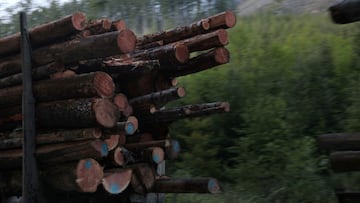Why are houses in the United States made out of wood?
In other countries, houses are often constructed of more durable materials like brick and concrete, while in the US they are mainly made out of wood.


Builders worldwide tend to favor materials like brick and cement when constructing houses as they tend to last longer than wood and can help keep homes either cool or warm depending on the climate. In the United States, wood has long been the preferred building material in the residential construction sector.
According to Valdus Construction, builders have opted for wood over brick in many parts of the country because “wood is a flexible material capable of withstanding low-intensity earthquakes or light tornadoes.” The price has also driven its popularity. Typically wood has been a comparatively cheap building material because of the ample supply provided by the country's significant logging industry.
However, domestic and global supply chains fell apart during the pandemic, and with a surge in demand paralleling this supply shortage, prices hit record levels. One report from April 2021 showed that the increase in the price of lumber had boosted the cost of constructing a single-family home by more than $35,000. As the market stabilizes, most experts are confident that prices will return to their pre-pandemic levels.
Historical availability of wood
When European colonizers first came to the United States, they opted to construct many houses and commercial buildings from wood because it was readily available. Additionally, many settlers chose wood as a building material because structures can be built more quickly than when using brick or cement.
However, this has come at a high environmental price.
Forest experts estimate that in 1630, around half of land in the US was forested, totaling more than 1.02 billion acres. By 1910, this level had fallen to approximately 721 million acres.
This widespread deforestation led to the endangerment and extinction of many animals and many other long-term consequences. In the twentieth century, deforestation and ecosystem degradation motivated many environmentalists to call on the government to exercise more control over the logging sector.
Nevertheless, the United States continues to be a significant player within the global timber market, occupying the top spot on the list of countries with the highest annual harvesting volumes.
Sustainability and Legality
When examining the wood product market and the laws that govern its trade, it is critical to understand that legal and sustainable are not synonymous. Just because there is a legal standard does not mean it aims to ensure the sustainable use of forest products, and visa-versa, a long-term forest management plan could be "sustainable" and still violate the law.
The Forest Legality Initiative at the World Resources Institute explained that many countries have shifted focus to legality to avoid debates over the metrics used to evaluate sustainability. In a 2018 publication, researchers wrote that "after years of debate, stakeholders had not been able to reach a consensus on what qualified as sustainable," which prompted many countries to place a greater emphasis on forest legality. This change allowed governments to enact laws that integrated sustainability to support the unique forest context in their country.
Illegal logging in the United States
The illegal wood trade is the fourth largest black market globally, costing governments up to $152 billion in lost revenue from the payment of taxes and royalties.
An analysis by non-governmental organizations reveals that it is not possible to differentiate between authorized and illegal logging in five of the seven states that produce the most wood in the Brazilian Amazon. https://t.co/H2b1aZAcmq
— InfoAmazonia (@InfoAmazonia) October 13, 2021
In 2008, the United States amended the Lacey Act to include timber and forest products. The amendment prohibited the import, export, transport, harvest, and storage of illegally sourced wood products. Under Lacey, private sector actors must practice due care to limit the risk of illegal material entering their supply chains.
The European Union, Australia, Japan, and South Korea have followed suit and implemented similar laws over the last decade. While these laws represent an essential step in restricting illegal trade, significant gaps in global supply chains still allow for wood products of illicit origin to make it into regulated markets.
The extent to which illegal wood products are entering the US market became evident after a study was published by the World Wildlife Fund, the World Resources Institute, and the US Forest Service Forest Products Lab. The organizations found that of the nearly seventy-five wood products examined, over half were mislabeled. This meant that the product had a certain species listed that was later shown to be inaccurate. Experts see mislabeling as one indicator that a product could be of illegal origin. The results show that many consumers are purchasing products that are being advertised falsely.
Mislabeling can be difficult to prove as it requires scientific testing to validate if the label is accurate. However, the Department of Justice has prosecuted various cases against US-based companies for failing to adequately control their supply chains. In 2016, Lumber Liquidators pled guilty and paid more than $10 million in fines after an investigation confirmed that some of their flooring products were illegally sourced from China and the Russian Far East.
Housing and the illegal wood trade
Related stories
Consumers have few resources to reduce the risk of purchasing wood products of illegal origin. There are fewer risks within the residential construction sector as many of the species used are not at a high risk of illegality. Many of the most common species used in the construction are softwoods like spruce, fir, and pine.
The risk is higher when looking at furniture and flooring (i.e., Lumber Liquidators). When buying these products, a few questions can be asked to gauge the measures taken by a retailer to reduce the risk of illegal material from entering the supply chain.
- How do you limit the risk of illegal products entering your supply chain?
- Do you know where these projects originated?
- Have these products undergone wood identification analysis to have their species verified?

